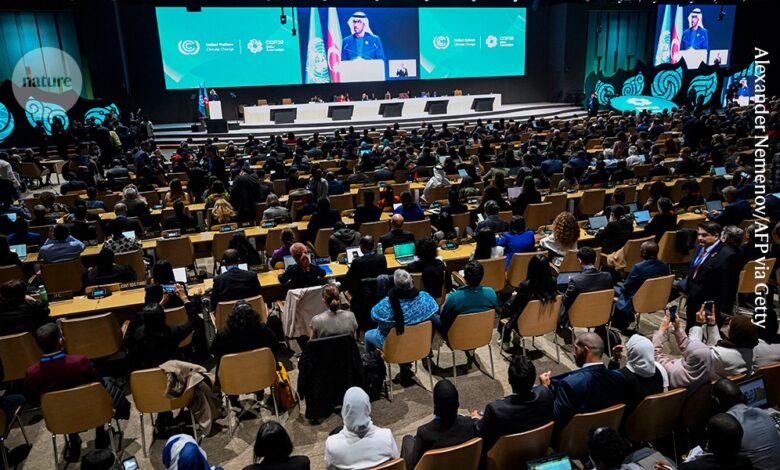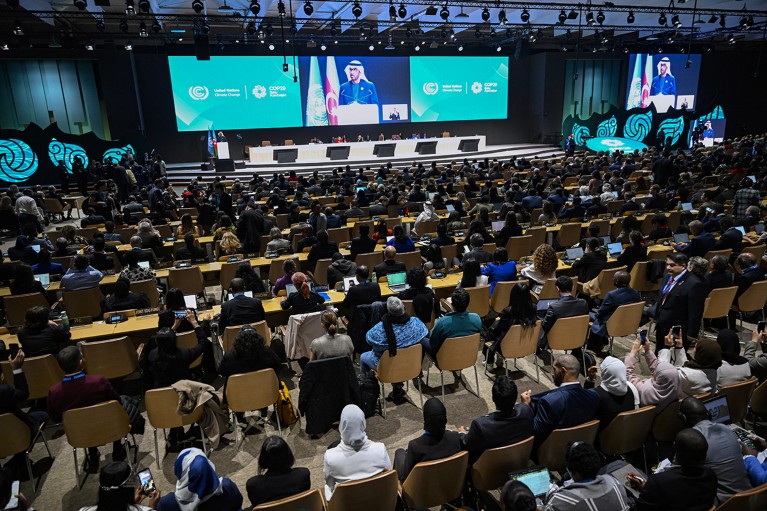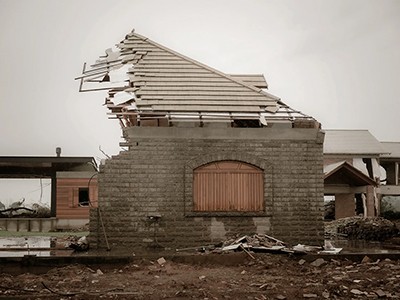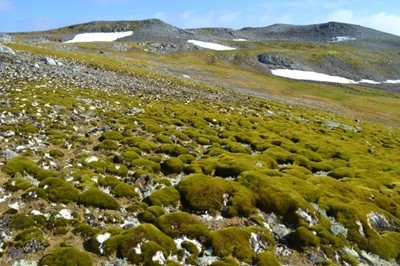

The COP29 climate summit, where negotiators from more than 200 nations will meet, opened on 11 November.Credit: Alexander Nemenov/AFP via Getty
Extreme storms fuelled by climate change have wreaked havoc across the world in 2024, including in Brazil and the Philippines. The average annual temperature for the globe could reach 1.5 °C above pre-industrial levels for the first time this year. But another worrying development for many attending this week’s United Nations climate summit in Baku, Azerbaijan, will probably be the re-election of Donald Trump as US president.
What Trump’s election win could mean for AI, climate and health
The last time Trump was in the White House, beginning in 2017, he pulled the United States out of the 2015 Paris climate agreement, a pact that governments made to prevent Earth from warming more than 1.5–2 °C by curbing their emissions. The US president-elect is expected to do the same after entering office next year. This is already casting a shadow over the 29th UN climate conference of the parties (COP29) as representatives from nearly 200 countries gather to discuss financial aid for low- and middle-income countries (LMICs) vulnerable to global warming. The summit runs from 11-22 November.
Negotiating a strong agreement without the United States — the world’s largest economy and its second-largest greenhouse-gas emitter — will be “very difficult”, says Niklas Höhne, a climate policy expert and co-founder of the NewClimate Institute in Cologne, Germany.
Here, Nature takes a look at what is on the agenda at COP29.
Another US exit
When the Paris agreement was inked, world leaders included a provision that any party seeking to leave the pact would have to wait until three years after it entered into force. This meant that Trump could not pull the United States out of the agreement officially until 4 November 2020. When US President Joe Biden succeeded Trump a little over two months later, he signed the paperwork to rejoin the agreement.
How to recover when a climate disaster destroys your city
This time around, the exit process will take only one year, but observers say the damage is in many ways already done. Trump’s election signifies that the United States is unlikely to keep its pledge, made under Biden, to cut greenhouse-gas emissions to 50% below 2005 levels by 2030. This could give other countries political cover to scale back their efforts under the agreement, says Joanna Lewis, who heads the science, technology and international affairs programme at Georgetown University in Washington DC.
A US exit could also spell more trouble for climate finance, the main theme of the summit in Baku. The United States has already failed to meet its commitment under Biden to boost international aid for developing nations to US$11.4 billion annually, to help them adapt to climate change and forgo industrialization that involves heavy pollution. The US Congress appropriated just $1 billion this year. And few see any prospects of the new administration under Trump, who has questioned the existence of climate change, stepping up.
The price of change
Industrialized countries, which are responsible for the bulk of historical greenhouse-gas emissions, have committed to helping ‘developing countries’ with climate funding under the terms of the UN climate framework. They put a dollar figure on that commitment in 2009: $100 billion annually.
COP28 climate summit signals the end of fossil fuels — but is it enough?
By some measures they hit that goal, albeit two years late, but researchers say much more is now needed. Negotiations at the summit starting this week will determine a ‘new collective quantified climate finance goal,’ to help developing nations, which are the least responsible for climate change and oftentimes the most vulnerable. Which countries will pay, how much and where the funds will go are up for discussion in Baku.
Estimates vary for how much money developing nations need to adapt, but the negotiations are likely to begin around $1 trillion annually, says Melanie Robinson, the global climate director at the World Resources Institute, a non-profit research organization based in Washington DC. Others say the need is much larger: one economic panel has estimated the need around $2.4 trillion annually by 2030.
Whatever the new finance goal is, methods for tracking how much funding wealthy countries are contributing towards LMICs will be discussed at the summit. Transparency is already a challenge because there is no broad agreement about what constitutes ‘climate finance’, says Romain Weikmans, a researcher who studies the issue at the Free University of Brussels in Belgium. “Every country has its own accounting methodology.”
Believe it or not, this lush landscape is Antarctica
For instance, Weikmans says, an LMIC might use funds from a wealthy nation to build a new school equipped with solar panels, but it’s unclear whether that wealthy country would report the whole cost of the school, or just the solar panels, as part of a climate investment. “My hope is that the new goal will be formulated in a way that makes it possible for observers to assess the extent to which it has been met or not,” Weikmans says.
Countries will also discuss whether financial aid covering the costs of disasters driven by climate change will be counted in the new finance goal. Wealthy countries pledged roughly $700 million last year to a new ‘loss and damage’ fund created to support nations suffering such disasters, but this “pales in comparison to the $580 billion in climate-related damages that developing countries could face by 2030”, Robinson says. This figure was estimated by researchers at the Basque Center for Climate Change in Leioa, Spain, and represents the maximum cost of damages that developing nations might encounter this decade.
The globe has already warmed 1.3 °C, and some are projecting that Earth will officially hit 1.5 °C this year. One message scientists are delivering to policymakers at COP29 is that the climate is changing, and the risks are increasing, faster than even a few years ago.
“This year we have seen severe weather events, droughts, extreme heat, flooding, hurricanes of a magnitude we’ve never seen before, and those impacts will not go away — even in the very best scenario,” Höhne says. As the world barrels towards an unlivable future, he adds, leaders at COP29 need to switch to “emergency mode”.
Source link








